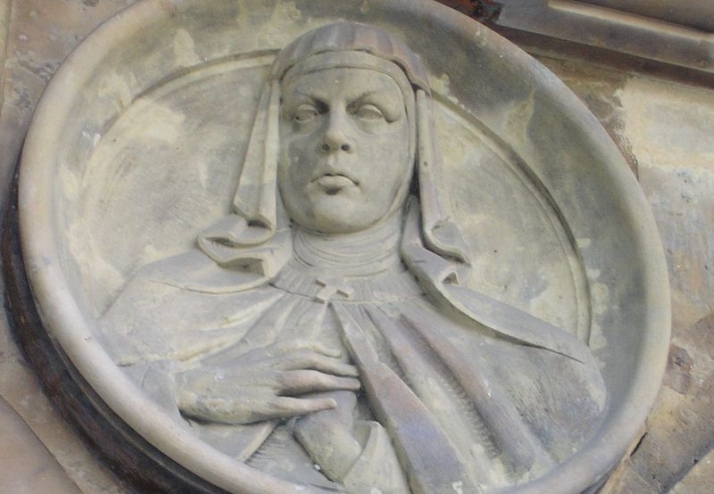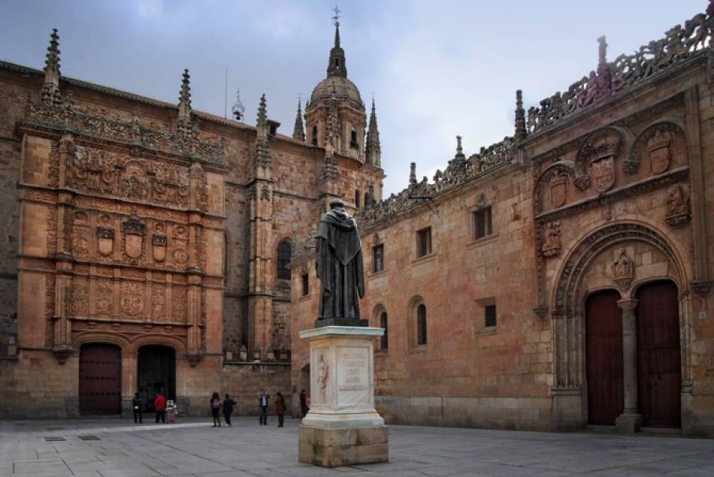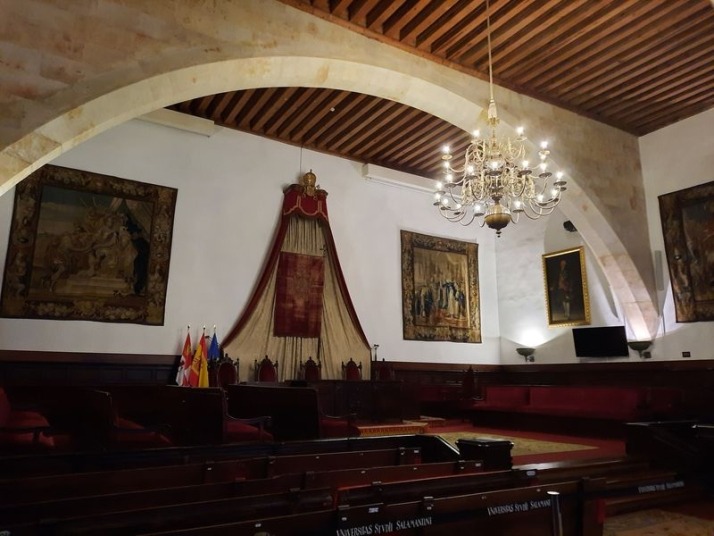Oh Doctor Optimum! (1)
Manuel DIEGO SANCHEZ, Carmelite
It is not the first time that Manuel Diego has done so, since he has just published two long articles on the Teresian centenary of 1922 in the ‘Revista de Espiritualidad’ and in the ‘Alba de Tormes October Festival Book’. He had also written about the subject in local newspapers, such as ‘El Norte de Castilla’ (10-17-1921), ‘Diario de Ávila’ (10-16-1921), and even in our digital newspaper. You can also visit the TERESIAN CENTENARY page on the Alba de Tormes Town Hall website.
*We offer, with the approval of “Revista de Espiritualidad” of Madrid, 2022, pp. 354-358 of the article by M. Diego entitled: “May we feed on his heavenly doctrine.” The situation and usefulness of the third centenary of the canonization of Saint Teresa (1922-1923)”. In the cited pages, he dwells on the Salamancan event that is commemorated today.
* * *
“The central act of the Salamancan honorary doctorate achieved the maximum repercussion and official participation, since it was honored for 3 days with the presence of the kings of Spain, in Salamanca, Alba de Tormes and Ávila. This happened from October 6 to 8, 1922, and it became the most brilliant act of the entire centenary, even -if one can speak like this- the most secular and free of religious and devotional connotations, although they were not lacking, but in a more modest dimension, without interfering in the academic act, which was the important one.
The calendar of these days was intense, but also very solemn due to the presence of the kings in all the acts:
– October 6: university act of granting the act in a solemn academic meeting inside the building of the old university of Salamanca, presided over by the kings of Spain;
– October 7: literary event organized by Catholic university students at the Liceo Theater in Salamanca, which was not attended by the vice-rector Miguel de Unamuno.
– October 8: imposition of the doctoral insignia by the kings of Spain to the processional image of Santa Teresa in Alba de Tormes.
The Salamancan academic act, in addition to the corresponding official reading of the approval of the doctoral award by the University, was very attentive to the representativeness of the various levels, even leaving room for the intervention of charro folklore in the act. Since King Alfonso XIII, the rector Luís Maldonado, a fervent Catholic, the bishop of Salamanca well aware of having achieved this success, the archbishop of Valladolid and even the then President of the Council of Ministers, Sánchez Guerra, intervened with their respective speeches or parliaments.
Thanks to the minutes drawn up from the solemn investiture session, we can find out the list of attendees at this academic act: in addition to the king and queen and their palace companions, the highest-ranking political figure was the prime minister and minister of war, José Sanchez Guerra; several senators and deputies; the mayor of Salamanca Federico de Anaya. The Archbishop of Valladolid Mons. Gandásegui; the bishop of Salamanca Julián de Diego Alcolea, and the bishops of Zamora, Ávila, Segovia, and Ciudad Rodrigo.
Regarding the academic faculty, in addition to the rector Luís Maldonado, we find the names of distinguished professors belonging to all the Faculties of Salamanca, although the attendance at the act of the vice-rector Miguel de Unamuno does not appear, who disagreed with the actual presence in it. But there were also members from other Spanish universities. While the clergy of Salamanca include illustrious names, such as Eloíno Nácar, Agustín Parrado, later a bishop; Manuel García Boiza (minutes of the university cloister, in La Basílica Teresiana 9 [1922] pp. 390-398).
This academic act was the most important, which was followed by the literary act of the Liceo theater (previously the Breton had been thought of) which was held the day after the academic investiture (October 7) and was also attended by the kings and many characters from politics and culture from Salamanca.
The double parchment of the doctoral award illuminated by the artist for Salamanca and Alba de Tormes can serve as a summary, and even as a reminder of this university gesture, which reads as follows:
“The Ordinary Cloister of the University of Salamanca, in a session held on March 4, 1922, agreed by acclamation to grant the title of Doctor honoris causa to the exalted Castilian writer Teresa de Jesús y Ahumada.
For the memory and example of present and future generations, we record in this document such a glorious ephemeris, in the solemn act of commemorating the Cloister the third centenary of the canonization of Saint Teresa of Jesus.
J. Sánchez Guerra Alfonso XIII Luis Maldonado”

In reality, this act did not culminate or finish, until the same kings traveled to Alba de Tormes on the 8th of the same month and placed the new doctoral insignia (doctoral cap and pen) in the processional image of Saint Teresa, to make visible the consequences of the degree obtained.
If we rely on a witness present to all these acts, the already Carmelite historian Silverio de Santa Teresa (1878-1954), in his memoirs still handwritten and difficult to read, tells us these details:
“Ávila had its glory by closing the centenary with a golden key; Salamanca that of opening him up intellectually, as he fulfilled his sober tradition and his traditional devotion to the Saint from the very life of the glorious Reformer for his friendship with professors as eminent as Fathers Medina and Báñez, and then for Fray Luís de León he has continued without interruption to this day. Exactly in the year of the centenary, he was rector of the glorious D. Luís Maldonado University, in which the nobility of language (?) and culture of letters always lived closely together and honored (?), and he was a great admirer of the Santa Castellana.
Ahead of the centenary date, on March 4, 1922, the Salamanca university faculty agreed by acclamation to award the title of Doctor “honoris causa” to the excellent Castilian writer Teresa de Cepeda y Ahumada. The agreement was sanctioned (?) by his majesty Alfonso XIII, his prime minister José Sánchez Guerra and the said rector Luís Maldonado. / 88/
On the occasion of this academic demonstration granted to the Saint, the federation of Catholic students of Salamanca opened (?) a literary contest with fourteen themes, all related to the incomparable writer (in footnote: It can be seen in El Monte Carmelo, August 1, 1922, p. 363). The collation ceremony of the Teresian Doctorate had to be celebrated with regal magnificence. The Kings were interested in it and [recibí la] personal invitation.
On October 6 they arrived in Salamanca with their entourage and the president [del consejo] of ministers, Mr. Sánchez Guerra. The ceremony of its celebration in the university paraninfo. The entire cloister was present with their colorful and traditional uniforms, according to the various faculties. After his speeches alluding to the act, Mr. Sánchez Guerra spoke, and finally, his Majesty Alfonso XIII.
In the afternoon a very lucid procession was organized, which, passing through the great Salamancan Square, one of the most artistic and harmonious squares known, splendidly illuminated, seemed like a piece of heaven had moved to earth to celebrate the famous Carmelite . The Kings were on the central balcony of the Town Hall. The one who writes this was in the procession, and what was my astonishment when, passing in front of them, Alfonso XIII deigned to give me a gentle greeting, answering him with an affectionate and reverent nod, and at the same time I heard some friendly charros who witnessed the procession: …”Damn, the King has greeted this friar! What a guy he will be!” I smiled and said softly: “if you only knew who this wretch is!”
/89/ Coinciding with the Doctorate celebrations, a solemn triduum was held in the Cathedral. On October 7, the second day of the triduum, his Majesties attended, and in the afternoon a brilliant literary function was held at the Lyceum, also presided over by his Majesties. A group of aristocratic young women, dressed as charras, extraordinarily excited the admiration of the public. A daughter of the Rector of the University, she played the role of the Saint very well. The comic incidents that the Saint describes with so much grace in the foundation of her Barefoot in this city, were widely applauded.
Other acts included the reading of a poem to the Saint by the young Cristina Arteaga, daughter of the Dukes of the Infantado, highly appreciated in the Catholic student circles, for her application and talent. The poetry had been outstanding, awarded by the Contest Jury with a medal of honor” (Burgos, Archivo Silveriano 113/D).
We leave the Silverian story here, because it entertains itself with no little irony in the details of how this literary prize was awarded to the poet Cristina de Arteaga (1902-1984), later a famous Hieronymite nun and whose beatification process is now under way. And then continues with the chronicle of the events of October 8 in Alba de Tormes.
All this act may seem to have been carried out without any mishap, and -strange thing- even decided unanimously, and so it was. Lately it has been possible to study its plot and way of visibly capturing the university decision shared by all. Well, the politics of the moment and the situation that the Salamanca university was going through entered. For this reason, some reactions have been known whose content enriches the judgment and the evaluation that this academic gesture deserves, which had so much public repercussion”.

One hundred years after the “Honoris Causa” doctorate granted to Saint Teresa of Jesus (10-6-2022)

